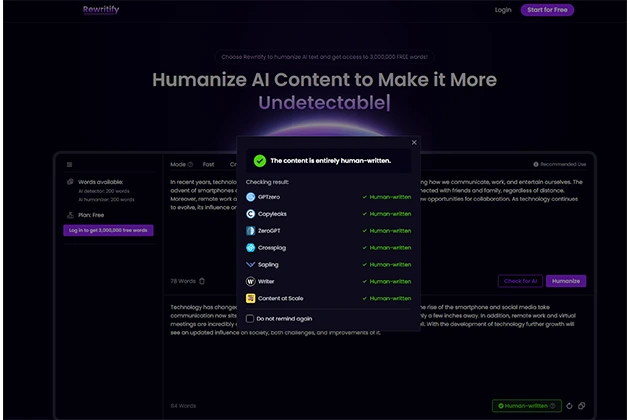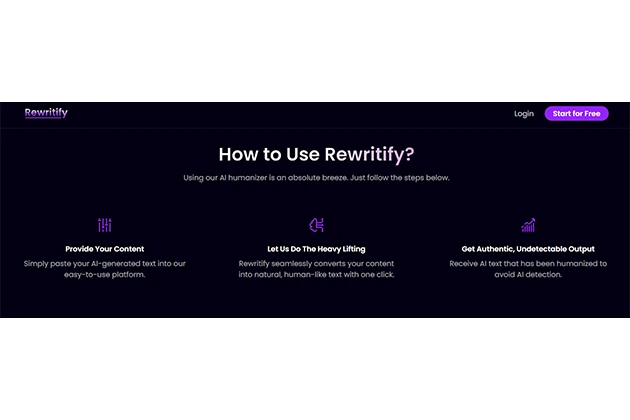AI tools have transformed the way we produce content, giving us agile and speedy ways to create pieces, from blog posts to research papers. For all that, one problem remains: content made by AI still sounds mechanical, is void of emotions, and can be recognized by readers as coming from a machine or other AI. When you use AI to write your news, product descriptions or social media copy, humanizing the content can influence whether it speaks with your audience.
This guide will cover how to convert AI auto-generated text into organic content that sounds more humanized and resonates well with the readers. And most importantly, helps you bypass AI detection tools.
Why AI-Generated Content Can Feel Unnatural
ChatGPT, Jasper, Copy etc. are AI writing tools In itself helping in generating the content faster. That said, these are pattern-based and most of the time algorithm-based or data-driven so that you can expect some issues to be surfaced:
- Common Sentence Structures — AI will generally rephrase this in a similar way curtailing the naturalness of content.
- Absence of a Personal Touch: AI-generated text lacks the emotional and creative nuance found in human writing.
- Slightly Too Perfect: AI content can be a little too good, missing those tiny discrepancies that provide conversational nuance.
- Misunderstandings In Context: Just because the article is of the right format and style does not mean the machine will grasp language, tone and context like a human.
That is where AI humanizers like Rewritify step in. With Rewritify, you can turn the AI stuff that sounds too artificial into something that naturally flows and connects with your readersBecome less recognisable to AI detection software than ever.
Steps to Humanize AI-Generated Text
Transforming AI content into something more human-like involves a combination of strategies. Here’s how to do it:
1. Clarity and Flow Edits to Start With
One of the first tasks that you have to do when you work with AI text is make it more clear and structured. AI has a tendency to create sentences that are clumsy or overly-wordy and the editor must work toward more concise and flowing language.
Subheading: Break Down Long Sentences
In addition, AI sometimes creates too complex and long sentences so a final text is unreadable. It’s also important to underline that such tools help you only to avoid grammar mistakes.(946) One good practice to avoid doing is to divide these sentences into short and easily understandable sentences. This is easier to read and it reads more naturally to your average reader.
Example:
AI Output:
“AI-generated text, while often efficient in its production, can sometimes lack the nuanced creativity that a human writer brings, and as a result, it can feel overly repetitive or formulaic, making it less engaging for the audience.”
Edited Version:
“AI-generated text is efficient but often lacks the creative nuance of a human writer. This can result in repetitive, formulaic writing, making it less engaging for readers.”
Subheading: Reorder Sentences to Ensure Coherency
The artificial intelligence does not always produce a work that flows with real words from one to the next. Keep an eye on any jarring leaps from one topic to the next, and if needed wiggle around the chapters to help create as smooth of a structure that works for you.
2. Include Personal Takeaways or Commentary
The other important part is adding a few details or thoughts that can be done only by humans. AI-generated text is fundamentally factual and impartial. This makes the content seem more genuine and down to earth than if they were not included.
Subheading: Empathize with Personal Antedotes
A small anecdote or a typical scenario can pack it with human feelings. This does not have to be overly personal — it may just mean playing off of shared experiences.
Example:
“Have you ever read an article that felt a little too robotic? That’s a common problem with AI-generated content—it lacks the warmth and personality that comes naturally when a human writes.”
Subheading: Use examples from the real world
It allows me to get context that AI normally miss in real world example. Draw on these examples to illustrate points and lay out concrete applications of the info you inherit.
3. Tone it down to fit the style
Getting the tone of your content correct is another huge part of making your content feel human. Content written by AI could be too stiff or impersonal, as while messing with tone depending on audience is a piece of cake for humans its not easy at all along the lines of AI mainAxisAlignment.AddModelError Changing this for it to be more interactive.
Subheading: Tone and Purpose
The tone should match the content being created. Blog Posts: Blogs should be written in a conversational tone. If you are working on a business report, or even academic paper, it is essential to write in a formal tone. Anyway, the tone should sound like a native-speaking person, which targets average Joes or Janes to begin with.
4. Mix up Sentence Length and Style
AI has a tendency of following the sentence length and structure akin to a pattern, which might be boring for humans to read. On the other hand, human writing has natural variety in sentence lengths and keeps the reader engaged.
Subheading: Blend Short and Long Sentences
It is also a good idea to break up your content with the use of sentences that are varying in length. Combining short, direct sentences with long and detailed ones can add rhythm to the exposition of the text.
Example:
AI Output:
“AI can be a useful tool in generating content quickly, and it offers a range of possibilities, but at the same time, the content it generates can sometimes be lacking in nuance.”
Edited Version:
“AI is a useful tool for quickly generating content. It offers a range of possibilities. However, AI-generated text often lacks nuance.”
5. Include some natural phrasing and idioms
It is hard for AI to create Casual Phrases and Idioms that are very common among Humans in everyday speech And it’s these nuanced differences that can often be the tell-tale sign that content was AI-created.
Subheading: In Form Of Plain Language
When relevant, include colloquial terms or sayings that a human would also be likely to use. It is these little bits that help de-automated the content.
Example:
Instead of “AI can assist in the completion of various tasks,” try: “AI can help you get a lot of different things done.”
6. Contextual Accuracy Review
But sometimes context can be lost in AI output, causing errors in facts or logic. Make sure the content is reading good as well as understandable in that particular context.
Subheading: Confirm Your Information
AI is really good for scraping general knowledge, but it gets a lot of the facts wrong. It is important to proofread AI generated content for the facts too, such as names, dates or statistics.
7. Emphasize Emotion and Empathy
But while Lola can write more fluently and faster than any human, she is incapable of imbuing her prose with emotion or empathy. Content such as this lacks the emotional touch that is an integral aspect of human writing
Subheading: Touching the Soft Spots of the Reader
If you can, use emotion-oriented sentences throughout the article. But they also can come in handy for persuasive writing, marketing content, or when you want to captivate your reader just that much more.
Example:
AI Output:
“AI-generated text can be used in various ways, such as content creation and data analysis.”
Edited Version:
“Imagine being able to create compelling content or analyze data at the click of a button. That’s the power of AI, but what if you could take it one step further and make it feel genuinely human?”
8. Make Use of Rewriting Tools: Rewritify for Final Touch
You should specify tools such as Rewritify to polish your content in new ways after editing them manually for the purpose of flow, tone, and clarity. Rewritify provides human like patterns of writing not just replacement of words, and this will make your AI generated text to look more like human written than made by other AI detectors.
Subheading: How Rewritify Function?
Rewritify specializes in processing large datasets of humanly written articles and other forms of human centric content with sophisticated algorithms making it very efficient to convert robotic AI based contents into a genuine Human-like text. Here’s how you can use it:
- Copy and Paste AI-Generated Content: Take any piece of content generated by AI that you wish to humanize, then paste it into the Rewritify platform.
- Select Your Mode : You can pick your desired mode after seeing the depth of changes you want like i.e “Fast”, “Creative” and so on.
- Rewrite Now: Let Rewritify GIve that content a make over resulting in books sounding like human text which is of course well versed.
Rewritify is a tool that enables your content to read well as well as pass AI detection software such like GPTZero, Originality. ai, and others.
9. SEO (Search Engine Optimization) Edit
Once the content feels human, it needs to get optimized for search engines. However, when you stuff your keywords or use them in unnatural ways generated by AI, then this can ruin the SEO of the content. One more thing is that keywords must always be natural sounding.
Subheading: Keyword Positioning
Be sure to include keywords within the title, headers and in general inside the text itself according to what sounds natural. Do not cram up the content with keywords as they start feeling out of place in a sentence.
Sub-Headline: Use Latent Semantic Indexing (LSI) Keywords
Those are some of the related keywords that let search engines decipher your content. Strategically placing these anchor text links enhances the SEO value of your content without making it overly keyword-oriented.
10. Recheck All sentences for Grammar and Uniformity
Lastly, make sure you proofread the content for grammar, spelling, and continuity. Although AI tools are typically reliable, they still can make mistakes when it comes to more complex grammatical structures.
Subheading: Read the content out loud
It is human-sounding — one of the best ways to know if your content passes this test is by simply reading out loud. If it sounds like something someone could say, then you can generally write.
Discover Bagoodex, the revolutionary AI chat experience that takes conversational technology to the next level! Just like the latest version of ChatGPT, Bagoodex harnesses cutting-edge advancements in artificial intelligence to deliver seamless, human-like interactions.
What sets Bagoodex apart? Its undetectable AI capability! Engage in conversations without the fear of being identified as chatting with a bot. Bagoodex blends effortlessly into your discussions, making it virtually impossible for users to distinguish between human and AI. Whether you’re seeking information, brainstorming ideas, or just having a casual chat, Bagoodex is your perfect companion.
With an intuitive interface and a wealth of knowledge across various topics, Bagoodex is designed for everyone—from tech enthusiasts to casual users. Experience the magic of AI that feels just right, and enjoy conversations that are as engaging as they are insightful.
Join the Bagoodex revolution today, where undetectable AI meets unparalleled conversational quality!











